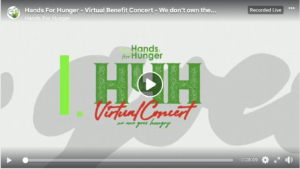END-OF-YEAR EVENT FUNDRAISING
The final quarter of the year unfolds with a blend of reflection and anticipation. As the days grow shorter and the year’s narrative approaches its climax, nonprofit leaders are presented with a golden opportunity: to rally their communities for one last, impactful push. Year-end fundraising events are not just about tapping into the season’s spirit of giving; they’re about celebrating the journey, acknowledging the challenges overcome, and setting the tone for the year ahead.
If you are thinking of hosting an engaging event to secure crucial support for your mission in the year ahead, whether traditional, virtual, or even a combination of the two, read on. We’re sharing ideas and resources on event fundraising.
Traditional Events
Traditional year-end fundraising events, such as galas, are meant to celebrate your hard work, reflect on your impact, and thank your donors and sponsors. As everyone rallies around your collective impact and gets inspired about the difference they can make, it’s helpful to offer multiple ways to support – whether through ticket sales, donations, sponsorship, volunteering, or a combination of the above. The multi-faceted approach maximizes the potential for contributions during and even before the event.

Flipcause Campaign Tips:
- Use a single landing page listing the event info and all the ways your community can get involved: buy tickets, donate, volunteer, sponsor—you can even add peer-to-peer—but try to stick to no more than 3 calls-to-action! Remember – the more buttons you add, the higher the likelihood someone will choose nothing at all.
- White-label your campaign URLs or use custom domains so your donors know it’s your organization! Here’s what a custom subdomain looks like on Flipcause:
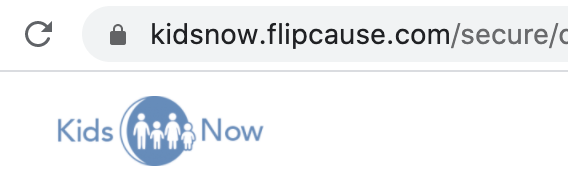
HYBRID events: Merging the Physical and DIGITAL
While traditional in-person events have their merits, the potential of virtual fundraising events is vast. Embrace the benefits of both traditional and virtual events by considering hybrid events. They offer an adaptable, cost-effective, and inclusive way for you to cater to local in-person attendees while also reaching a broader audience online.
10 Reasons to Consider Including Virtual Events Into Your Event Strategy
1. Global Reach:
Virtual events break geographical boundaries. A nonprofit can engage supporters from all over the world, expanding its audience far beyond its local community.
2. Cost-Effective:
Virtual events often come with reduced overhead costs. There’s no need to book a venue, handle on-site logistics, or cater to attendees, which can save a significant amount of money.
3. Accessibility:
Everyone can participate in a virtual event, including those who might find it challenging to attend in-person events due to disabilities, health concerns, or other personal reasons.
4. Flexibility:
Virtual events can often be accessed on-demand. If supporters miss the live event, they can usually view recordings later, ensuring that your content has a longer shelf-life.
5. Engaging & Interactive Tools:
Modern virtual event platforms offer a myriad of interactive features, such as polls, chats, and breakout rooms, which can enhance attendee engagement.
6. Data Collection:
Virtual platforms can provide valuable data analytics, from attendee numbers to engagement metrics. This data can offer insights into what works and what doesn’t, aiding in refining future fundraising strategies.
7. Safety & Convenience:
Virtual events eliminate risks associated with large gatherings, such as health concerns or adverse weather conditions. Attendees can participate from the comfort of their homes.
8. Environmental Impact:
Virtual events have a lower carbon footprint. There’s no need for physical transportation, printed materials, or other resources that might harm the environment.
9. Increased Sponsorship Opportunities:
Virtual events provide new avenues for sponsorship, such as branded virtual backgrounds, sponsored sessions, or digital swag bags.
10. Hybrid Possibilities:
Nonprofits can combine the best of both worlds by hosting hybrid events, catering to both in-person and virtual attendees. This approach maximizes reach and engagement.
We’ve gathered some creative ideas and real-world examples to help get your juices flowing. At the bottom of this post, we’ve also listed additional resources for setting up virtual events.
1. VIRTUAL galaS & HYBRID CELEBRATORY eventS
Engaging Both In-Person and Online Guests
In today’s dynamic world, hybrid galas offer a perfect blend of traditional charm and digital convenience.
Just like for your typical gala, you’ll want to recruit inspiring guest speakers, performers, and influencers. Integrate live shoutouts, interactive polls, live shoutouts, and rotating break-out rooms to engage online attendees. (Zoom and similar services offer all or most of these features in one).
SIPA did an incredible job setting up their virtual fundraising gala, complete with entertainment, speakers, and sponsorship showcasing.
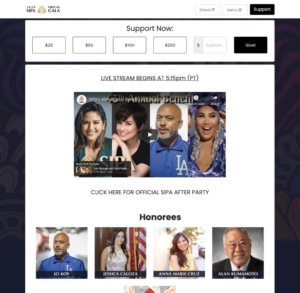
Here’s how you can ensure everyone, near or far, feels involved:
Dinner and Drink Pairings:
-
- In-Person: Offer a curated menu at the event, highlighting specialty dishes and drinks.
- Online: Share recipes in advance so virtual attendees can prepare and enjoy the same dishes at home. Consider sending beautifully designed recipe cards as a tangible touchpoint.
Best Dressed Contest:
-
-
- In-Person: Set up a photo booth or stage to showcase attendees’ gala attire.
- Online: Encourage virtual attendees to show off their outfits, possibly with themed backgrounds. Celebrate the blend of physical and digital by rewarding categories like “Best Dressed” or “Most Creative Virtual Background.”
-
Donation Incentives:
-
-
-
- In-Person: Offer tangible perks, like exclusive swag or unique experiences at certain donation levels.
- Online: Drive donations by offering virtual party kits or digital goodies for participants.
-
-
Thanking Sponsors:
-
-
- In-Person: Showcase sponsor logos or messages at prominent locations throughout the venue.
- Online: Acknowledge sponsors with special shoutouts during the virtual stream or with branded digital assets.
-
The Beauty of Virtual Flexibility:
Virtual elements in a hybrid event come with their own set of advantages. They’re often more cost-effective, eliminating venue, catering, or logistical expenses for that portion of your audience. Plus, with today’s technology, they can be quickly set up, making them perfect for organizations on tighter budgets.
Larry and Toby Milstein threw a virtual gala, aptly named “Zoomtopia,” which benefited the World Health Organization and the International Medical Corps. Organized in mere days and promoted entirely on Milstein and friends’ Instagram pages, they exceeded a whopping $20,000 in donations, and the event cost them nothing to put together.

By integrating these ideas, you can create a memorable gala experience that resonates with both your in-person and online community, maximizing engagement and fundraising potential.
2. benefit concerts & live performances
Embracing the Hybrid Stage
In an era where audiences seek both in-person experiences and online convenience, the magic of live performances can be amplified through a hybrid approach. By merging physical venues with digital platforms, you can captivate both local attendees and a global online audience.
Hybrid Concert Insights:
- Physical Stage: There’s an undeniable energy that resonates in a venue filled with live music and an engaged audience. Leveraging this atmosphere, you can offer exclusive experiences, merchandise booths, and direct interactions with the artists.
- Digital Stage: Using platforms like Twitch or Zoom allows performers to connect with a wider audience. It provides an opportunity to draw talent from across the globe and broadcast to fans who might not be able to attend in person. On a live stream, your audience can interact publicly via a sidebar chat, but the main focus remains on the performance itself. While platforms like Facebook or Instagram Live offer convenience, prioritize platforms that offer superior audio and video quality to enhance the virtual experience.
This is a sweet example of an annual holiday concert turned virtual from Daughters of St. Paul. In lieu of their traditional in-person performance, they hosted a Virtual “Home for Christmas” Concert (literally). Sponsors received a free song download from the choir:
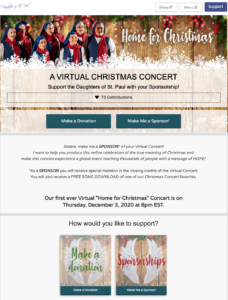
Hybrid Concert Tips & Ideas:
- Star Power: Engaging popular performers can significantly boost attendance, both in-person and online, enhancing the event’s appeal and fundraising potential.
- Sponsorship Opportunities: From digital banners during the live stream to physical banners at the venue, there are numerous avenues to acknowledge sponsors. Consider exclusive offerings, like virtual breakout rooms for online VIP attendees or backstage passes for in-person supporters.
- Exclusive Content: To incentivize higher contributions, offer perks like exclusive recordings of the event, behind-the-scenes content, or virtual meet-and-greets with performers at higher donation levels.
Hands for Hunger raised over $12,000 in donations through its first Online Virtual Concert.
3. GAME NIGHTS & CRAFTING
Building Community Both Onsite and Online
Interactive events like game nights and crafting sessions are perfect opportunities to engage supporters in a fun, relaxed environment. Whether attendees are physically present or joining virtually, the essence is to create a sense of unity and shared purpose.
Hybrid Engagement Ideas:
- Physical Gatherings: Host events in a communal space, providing materials for crafts, setting up game boards, or organizing team-based challenges. For added touch, consider offering refreshments or themed decor to enhance the ambiance.
- Virtual Participation: Using platforms that support interactive features can make online attendees feel just as involved. For crafting, consider sending out kits with essential materials and instructions ahead of time. For games, utilize online platforms that allow multiple players to join from different locations.
Hybrid Game and Craft Night Tips:
- Ticketing & Donations: Offer tickets for in-person attendees to cover venue and material costs. For virtual participants, consider a pay-what-you-can model or a fixed ticket price. Additionally, integrate a text-to-give donation option during the event for spontaneous contributions.
- Don’t be afraid to call on your supporters! This is a great opportunity to leverage peer-to-peer fundraisers to organize their own fun night of their choice and gather friends for a good cause.
- Make it easy for supporters to start a fundraising campaign on your behalf. That way, they can select their own online board games, host trivia, virtual bingo, or online game tournaments.
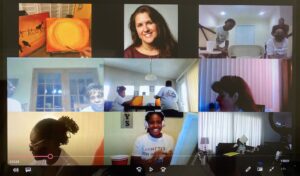
Tutoring Art can even host Virtual Painting Fundraisers & Instructionals on your organization’s behalf.
4. speaker events & Rallies
Bridging Physical & Digital Audiences
Thankfully, there are some unexpected benefits to going virtual with a rally or speaker event! While the in-person component caters to local supporters, the virtual component ensures that geographical boundaries don’t limit your message. You can engage with supporters from all corners of the world, and save costs on travel and venues.
Platforms like Zoom, combined with tools like Switcher Studio or Restream, enable seamless streaming across multiple social media channels. This means you can engage audiences on their preferred platforms, from Facebook to YouTube, and allow panelists, speakers, and a facilitator.
Hybrid Speaker Event Tips:
- Tech Supervision: Designate a technical person to handle both in-person AV needs and online streaming logistics. Pre-event testing, managing screen sharing, sound checks, managing waiting rooms, and cueing speakers will help your event run seamlessly!
- Integrated Campaigning: Your event page or campaign page should cater to both sets of attendees. Include easy-to-find links for online donations, email sign-ups, and other relevant calls-to-action.
- Unified Messaging: Whether someone is attending in-person or online, the event’s core message should resonate clearly. Conclude with a compelling call-to-action, motivating attendees to share the event’s message, support the cause, or become active fundraisers for your year-end objectives.
In June 2020, in the midst of a global pandemic and a fight against racial injustice, #GivingTuesdaySpark leader, 13 year old Khloe Thompson wanted to offer young people a space to learn, feel less alone, and take action safely. She planned a virtual rally for kids, bringing in activists and educators to talk about racism and mental health.
– GivingTuesday: How to Organize a Virtual Rally or Event
5. virtual 5K cruise
A run, walk, or 5k race remains a classic fundraiser, uniting communities in active, exhilarating fun. In today’s hybrid world, this event can be transformed to ensure everyone, near or far, can participate. Whether it’s on the familiar trails of a local park or the quiet streets of a distant town, supporters can join in physically or virtually. You can turn your regular event into a “virtual cruise” which has the benefit of added accessibility and allows your supporters to complete their route within a week’s time. Participants can use an activity tracker like Strava or Map My Run to record their run/walk/hike/ride/cruise and post a screenshot to their campaign page once they complete their personal goal, creating a unified event feel. Just like a typical 5K, you can charge an entry fee to participate or encourage participants to raise funds based on their milestones. For those wanting a twist, consider introducing themed segments, like a “Walk-Your-Dog” section or a “Costume Dash”!
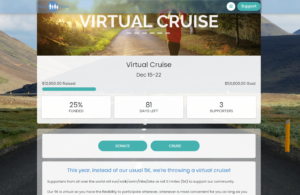
Hybrid 5K Event Tips:
- Routes & Virtual Paths: For local participants, suggest scenic routes using Google Maps or Map My Run. For virtual participants, encourage them to chart and share their own unique paths.
- Unified Hashtag: Foster a sense of community by creating a unique event hashtag. As participants share their journey on social media, this hashtag will thread their experiences together.
- Rewards & Recognition: Offer incentives that resonate with both in-person and online participants. Think swag bags, digital badges, t-shirts, or virtual recognition ceremonies.
- Music & Motivation: Curate a playlist that participants can tune into, ensuring everyone’s steps are set to the same beat, irrespective of where they are.
- Team Spirit: Utilize a peer-to-peer campaign to let your supporters create teams and recruit their friends and families.
By merging the tangible energy of on-ground events with the expansive reach of virtual platforms, nonprofits can ensure their 5K run/walk event truly goes the distance, engaging supporters every step of the way.
End-of-year and event fundraising is always a lot to take on! But with great challenge comes great opportunity, and we hope this information helps make it all more manageable.
Do you have any tips, inspiration, or ideas to share for how nonprofits are handling end-of-year event fundraising this year? If so, leave a comment below–we’d love to hear it!
Additional Virtual Event Resources
- Safety Considerations for Online Events
- 30 Tips and Tricks for Hosting a Successful Online Event
- Virtual Events Best Practices and Vendor Resource Guide – a very thorough guide from Achurch Consulting and Ellipsis Partners. (Skip to page 18 for an extensive list of vendors for all and any virtual event needs.)


